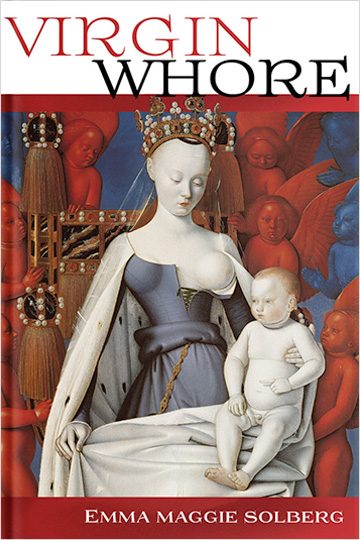'Virgin Whore’ Reveals a Provocative Virgin Mary
By Tom PorterWhen Assistant Professor of English Maggie Solberg chose the title for her recently published portrayal of the Virgin Mary, she fully intended it to be a provocative one. Virgin Whore (University of Cornell Press, 2018) explores the sexuality of the holy mother as it was portrayed in late medieval times.

“I meant the title to be provocative, because it’s a book about obscenity and blasphemy, at least on the surface,” Solberg explains. “I say ‘on the surface’ because if you look closely at the material I’m writing about, you’ll see that, in essence, it is deeply devotional.” The book’s cover could also be called provocative: It shows a detail from a fifteenth-century painting of the Madonna preparing to breastfeed her child, a naked breast clearly on display. Far from being blasphemous however, says Solberg, images like these remind us of a forgotten interpretation, where the mother of Christ was frequently portrayed as a bawdy and licentious character, as well as the paragon of virtue she is regarded as today.
Obscene yet Devotional
Solberg illustrates her point by highlighting a number of examples from the culture and literature of late medieval England. She talks about the presence of the promiscuous Virgin in works by well-known fifteenth-century authors like Geoffrey Chaucer and Thomas Malory. Solberg also cites a cycle of medieval mysteries known as the N-Town plays, in which Mary is represented not only as a virgin and a mother, but also as an adulteress whose voracious sexual appetite devoured mortals and angels alike.
“This kind of play—in the case of N-town there were forty-two of them—was performed by local communities across England, and fragments of about a dozen of the scripts have survived,” explains Solberg. “You can’t deny that from a modern perspective the plays are obscene: so much so, that when a theater director tried to stage them last century, he was arrested for blasphemy!”
You may wonder how it is that something considered obscene could also be highly devotional? To answer that question, says Solberg, it’s important to understand how radically different the perception of virginity was in medieval times. “It was a much more flexible definition. Virginity could be considered a sign of power, rather than a sign of purity. In the case of Mary, her virginity makes her invulnerable, and, although she is a mortal human, she is loved by God more than anyone else.” According to medieval lore, Mary exploited God’s love of her and used her charms to seduce him, persuading him to redeem mankind, which he wasn’t going to do, explains Solberg. “So, in effect, Christians owe their salvation to Mary and her charms.”
Then Came the Reformation
“In the Middle Ages, there was a range of options for describing Mary, a buffet table of choice if you like,” says Solberg. After the Protestant Reformation arrived in the sixteenth century, however, that buffet became severely limited. Earlier representations of the Virgin Mary were suddenly not OK. Statues and other art treasures were torn down and sometimes burned in an outburst of iconoclastic enthusiasm that was particularly prevalent in England.
“The new, Protestant Virgin Mary was portrayed as pure and virtuous, and became more so with the passing of each century,” said Solberg. The earlier representations have become largely forgotten, although, she argues, they are there in plain sight to anyone who studies the texts. “I make the argument that the existence of the myth of the promiscuous Virgin in pre-Reformation culture has been an open secret among medievalists, and I want to draw attention to this.”
Solberg denies there’s anything blasphemous about her latest book. What she is doing, she says, is shining a light on a slice of history. “You can disagree with me, but you can’t deny the fact that these plays, and other texts, were written. As a literary historian, I don’t think anything that’s written should be forgotten or ignored.”



